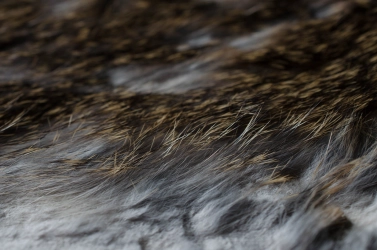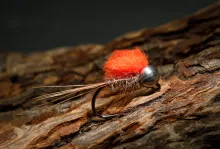I have a dried hare skin, which I have owned for as long as I have tied flies. A lot of flies and a lot of wisdom has come from that skin.
The first fly tying materials I ever bought, I bought on the same day that I bought my first vise and tools. The materials were – apart from some thread and some hooks – a couple of bits of deer hair, some marabou, some dubbing and some yarn. I soon added some flash and some tinsel, and a golden pheasant skin was also bought and put into my very small fly tying box.
But shortly after that something significant happened. I was in one of my local tackle shops talking to one of my favorite shop clerks, asking for hare’s mask. He did what he has done many times since when I shopped there: he asked me to follow him into the basement where the shop had their storage. I later realized that this was a special privilege, only granted to a select group of customers. What made me deserve this privilege is beyond me… but never the less, we went down the stairs, and I entered a new world.
The basement was penetrated by a very special odor, in particular from all the stuff that they repacked for specimen fishermen, which included a lot of odd materials including vanilla flavored cake flour, various scented oils and quite a few other very pungently smelling substances. Carp obviously loved this stuff... and so did carp fishermen.
Mixed into this was the smell of naphthalene – moth balls essentially – which was a smell emitted from the storage of bulk fly tying materials. As most people know, one of the ways these shops make money is cutting up bigger pieces into smaller pieces and putting them in small plastic bags. Small pieces sell at way higher prices than big pieces, and it’s a perfect business model, which just requires some time, a knife or a pair of scissors, a handful of small plastic bags and some labels. Same thing with the cake flour. Buy big bags, divide into smaller, and specimen fishers will pay bleeding under their nails for these small portions.
Fly tyers and specimen anglers… equally gullible… but that’s a whole other story.
Back to the story of the basement and what was down there: my first fly tying revelation! The small, prepacked bags in the shop with their fairly high price tag and pre-selected bits of material actually came from bigger pieces or batches containing all the variants: longer, shorter, darker, lighter, softer, stiffer etc. etc.
Down here I could not only see the full pieces and bags with many bits, but I was – in due time – even allowed to pick from them and get exactly what I wanted!
On this particular day, the clerk dug out a package, wrapped in greasy, smelly brown paper. When he unwrapped it, it revealed a greasy, smelly, dried hare skin. A full skin without the mask.
“Here”, he said. “Take this. It will give you hare’s wool for quite a few flies”.
He has no idea how right he was!
He has no idea how right he was!
I don’t remember paying for it, but I most likely did, but probably only paid a few dollars, because honestly: it seemed worthless. Smelly, sticky, greasy and stiff. Impossible to cut up into nice pieces, and essentially useless for him as merchandise in the shop.
To me it was worth a lot.
It opened a new world to me.
I still have this skin, and still use it, and it has bunches of material left on it. It will, in spite of being very well worn, last me many years to come and deliver materials for hundreds of flies. This is most likely the oldest material in my collection – at least the oldest one with a good story attached to it.
I have learned many things from buying, owning and using this skin. Let me try to list them:
- Dirty, smelly, greasy, messy does not mean worthless or useless. I have preached this before, and will do so again here and now: wash your materials! I took this skin home, dunked it into a tub of lukewarm water and left it there for 15-30 minutes. Long enough to soak the fur and dirt, but not long enough to soften the skin completely. Remember this was a dried skin, not tanned. So it was stiff.
Once it was wet, I took some ordinary shampoo and washed it. Like I’d wash my hair: rub in the soap, leave it there for a bit, rinse with tap water. I did this a few times, and man, did dirt come out! The first round of water was brown, the next one just foggy and the last one almost clear. At this point the backside of the skin was slightly soggy and wet, and I could scrape off fat, tissue and other things now soft enough to be removed.
I then dried the skin with an old towel, combed it a bit with an old plastic comb, and left it to air dry. It took a couple of days. The hairs were nice, the smell gone and the skin was back to its cardboard stiffness. I haven’t done anything to it since then, and this is probably more than 30 years ago. Even though it's well worn now, it's still going strong.
I unpacked it recently to use it, and noticed an unusual large amount of loose hairs and dandruff-like "scales". I took my vacuum cleaner and gave it a good round, hoovering out all the loose stuff, and even though a lot was literally sucked off, plenty is still left on. And there are no signs of moths or other pests. - Dried can be just as good as tanned. We usually consider tanned skins better than dried. They are nicer to touch, soft and pliable and almost always way cleaner than the dried stuff. That’s because tanned is basically always made for the clothing industry, and tailors seem to be picky when it comes to skin quality. Much pickier than fly tyers. Dried skins are fine unless we need the soft leather, like for zonker strips. Bird skins are basically always dried. We pluck off the feathers and don’t use the skin. Same thing for my hare skin: I don’t need the skin, only the hairs and fur, and getting that off the dried skin is fine.
- A full skin beats any selection of skin patches – even if you have all the patches from a single skin. When you have the full skin, you have all the variations of material on that skin: density, texture, color, length. And you have it well organized and know where to find the quality you need.
Hare skins, rabbit skins, fox skins, bird skins. Get the full skin if you can, and not patches or loose material.
And since the skin is close to symmetrical, you have two of everything, which in the case of bird skins means that you have the symmetrical counterparts of any bit you pluck or cut off the skin. Not so much in animal skins. There you just have more material. - Hare’s wool is one of the most useful materials you can get, and you shouldn’t be without it. A hare’s mask can bring you some of the way, but a full hare skin – or a “hare colored” rabbit skin – will do just as fine and maybe even better, because it has a larger selection of hair and much more of it.
Getting your own hare's skin is a question of knowing someone who hunts hares. The animals are skinned before they are cooked, and I'm sure the skins are usually just trashed.
Many butchers and fish mongers also sell hares for cooking, and will usually have the animals with the fur, and skin it for you when you buy it. It might raise an eyebrow if you ask for the skin, but I'm almost sure you will get it. You might even be able to pick up a skin without buying the animal.
Get a skin or two as fresh and unblemished as possible, and dry them as described in this article about chicken skins. Remember to wash them once they are dry.
Alternatively you can visit a hobby shop or a furrier (pelt shop), and ask for a "hare colored" or "wild colored" rabbit skin. You want a natural skin, and not a dyed one. This will be tanned, but equally useful, and the tanned and soft leather will even allow you to cut zonker strips from the skin.
SHWN
I have tied hundreds of flies from this skin, one of them a very simple, generic nymph suitably called the Simple Hare’s Wool Nymph or SHWN. This is not a patent worthy pattern (if any pattern is!), but just a simple example of how universally useful the hare’s skin is. You can tie the same fly using a hare’s mask, but the mask won’t last you more than 30 years of tying, like this skin has done for me! As noted above, a “hare colored” rabbit skin can also do the trick, and as you can imagine, essentially any skin that has guard hairs and underfur will be able to supply material for this fly.
The fly is the “One Note Samba” of flies. It uses hare for the tail, hare for the body and hare for the hackle, and only uses tying thread apart from that. The loop made for the rib even doubles as a hair hackle loop, so the fly has very few tying steps too. Super simple, and even easy to tie, the hair hackle being the only just slightly tricky part.
It’s a scruffy fly, and doesn’t require much finesse. I usually get hare’s hair all over the place when I tie it: in the beard stubble, in the nose, on the clothes and in the eye of the fly. It’s almost impossible to avoid. It’s the blessing and the curse of the hare’s wool: it’s thin, fine and long, and sticks to everything! That is what makes it so good for dubbing, but also what gets it into every crevice and onto every surface when you use it.
You can tie this fly with a bead or some weight under the body to get a faster sinking version, but mostly I just tie it on a suitably heavy nymph or grub hook, and that adds enough weight.
It’s the blessing and the curse of the hare’s wool
- Log in to post comments



















